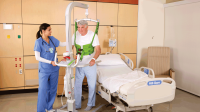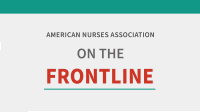Nurses make powerful advocates for causes that matter.


“Let me tell you about my experience.” That simple phrase, spoken by nurses to lawmakers in Congress, state legislatures, and even city councils, carries tremendous weight.
Our lived experience as the largest group of healthcare providers who see patients in all care settings and all stages of life makes real what otherwise can be dry and abstract policy discussions. It also vividly highlights our expertise and unique insights into the healthcare system and the challenges we and our patients face.
Curating collective experiences of school nurses
Fostering nurse-physician collaboration through shared experience
Clinical experience, poetic expression
Sharing our experiences face-to-face or online through op-eds, blogs, and the like, reflects the very best of advocacy—the process of gaining public support for a cause or policy.
For some nurses, the idea of meeting with lawmakers or posting their positions publicly is a non-starter—and that’s okay. Advocacy takes many forms, and an individual can be as involved as they would like while still making a difference. As a baseline, we can all keep informed about key issues that affect us and our patients and vote with these matters in mind.
A simple and easy way to do so is to visit RNAction.org. This up-to-date resource, maintained by the American Nurses Association (ANA) policy and government affairs team, details ANA’s analysis of and positions on proposed federal legislation and regulations. RNAction.org also provides a convenient way for nurses to voice their support for legislation and learn more about their representatives and candidates for federal office. ANA members who wish to be even more involved can contribute to or join ANA’s nonpartisan political action committee (PAC), which supports federal candidates who demonstrate a commitment to nurses and our patients. Members also can access ANA’s guide for engaging with legislators. This resource emphasizes the power of forging relationships with lawmakers (nursingworld.org/practice-policy/advocacy/ana-advocacy/guide/).
Considerable policy and regulatory work affecting nurses also takes place in every state. ANA’s constituent and state nurses associations have active and engaged policy committees and state PACs that complement ANA’s federal efforts.
As citizens of our communities, nurses also show up and contribute outside of our professional lives. Our neighbors see and get to know us, our work, and the causes we value. This matters.
Our collective voice in educating policymakers and building consensus for nursing issues counts. Without our input, decision-makers will have only the perspective of those who don’t walk in our shoes or fully appreciate our interests.
The advocacy process can be long and challenging. Change generally comes incrementally and almost always requires compromise, sometimes with people we disagree with on many issues. Ongoing outreach and education efforts are vital even when legislators oppose our positions. We’re fortunate now to have a relaunched Congressional Nursing Caucus. This bipartisan body is a vital ally in gaining support for our policy priorities. 2024 ANA Hill Day on June 27 will provide an excellent opportunity to share our experiences directly with lawmakers. (See RNAction.org for updates.)
About a quarter of state legislatures in this federal election year aren’t in session. But policy and regulatory actions in these states—like all others—are still occurring. Nurses’ voices count here too, as a law’s implementation is as consequential as its passage.
Nurses hold different positions politically and live and work in different places. When we unite in our advocacy across these differences, we can achieve our common goals: appropriate staffing in healthy work environments, proper value in the healthcare system, and elimination of healthcare disparities. This reflects the power of nursing and our potential to bring about a healthy world.


Jennifer Mensik Kennedy, PhD, MBA, RN, NEA-BC, FAAN,
President, American Nurses Association
American Nurse Journal. 2024; 19(3). Doi: 10.51256/ANJ032416




















